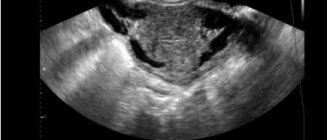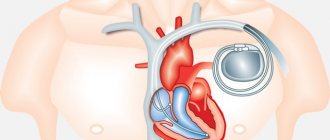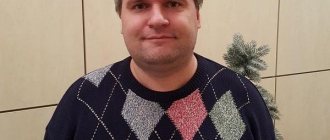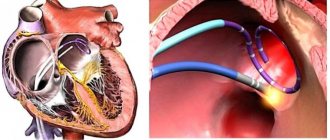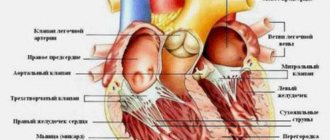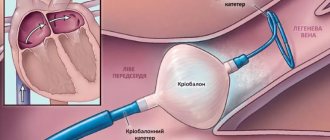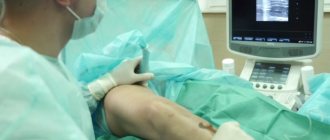Radiofrequency obliteration (ablation) of veins (RFO, RFA) – an intravascular technique for the treatment of varicose veins of the lower extremities, which involves the action of high-frequency currents (radiofrequency radiation) on the inner surface of the vein, resulting in the closure of the lumen of the vessel (obliteration) and its subsequent complete resorption (ablation). Radiofrequency vein obliteration is a modern, minimally invasive and one of the safest methods of treating varicose veins.
To perform minimally invasive obliteration of the veins of the lower extremities, the VNUS Medical Technologies radiofrequency coagulation system, consisting of a radiofrequency generator and electrodes, is used.
Briefly about the treatment method
Chronic venous insufficiency in varicose veins develops due to incompetence of the venous valves and reverse blood flow through the saphenous veins (reflux).
Modern technologies for treating varicose veins involve eliminating this reflux, which leads to recovery. Endovenous radiofrequency ablation (EVRF) is one of the effective and painless methods to eliminate this reflux. Endovenous radiofrequency obliteration works by heating the tissue of the venous wall by treating it with microwaves. The effect of exposure to microwaves is to heat tissue to the temperature of protein coagulation. The varicose vein is destroyed by this temperature and becomes obliterated (overgrown). Thanks to this, the reverse discharge of blood through the dilated veins stops, and the venous outflow is normalized.
The advantage of radiofrequency obliteration is the absolute painlessness of the postoperative period compared to other methods of treating varicose veins.
Advantages of treatment at the ISC
To treat varicose veins, our clinic uses advanced RFO technology from the Belgian company F Care System. This technology involves direct heating of the affected vein with a radiofrequency probe. The latter has a small diameter, comparable to laser fiber for EVLT, and therefore can be carried out into tortuous veins of any diameter, including tributaries and perforators. The EVRF technique from F Care System allows for effective treatment of varicose veins, spider veins and spider veins.
Preparing for treatment
After examining a phlebologist and determining the indications for treatment of varicose veins using the RFO method, it is necessary to carry out a number of tests:
- General blood analysis
- General urine analysis
- Blood tests for RW, HIV, hepatitis
- Coagulogram
Before the intervention, the phlebologist uses an ultrasound scanner to mark varicose veins and determine the necessary treatment plan. Pathological discharges, perforating veins and large varicose tributaries are necessarily noted. Based on the venous anatomy, the point for installing the intradusser to enter the varicose vein is determined.
It is advisable for the patient not to take food or water 4 hours before surgery, so as not to provoke vomiting during local anesthesia. Clothes should be light and easy to take off.
Rehabilitation
The effectiveness of radiofrequency ablation directly depends on the patient’s compliance with the instructions of the attending physician, namely:
- do not drive a vehicle on the day of the intervention;
- do not take a hot bath, do not visit baths and saunas for one month;
- wear compression garments for one to two weeks;
- Take daily walks lasting at least an hour;
- avoid prolonged standing or sitting;
- avoid heavy physical activity.
You can make an appointment for a consultation and find out the prices for treatment by calling the 24-hour phone number of the Stolitsa clinic: 8(495)604-10-10. We provide a wide range of services for the treatment of varicose veins; our specialists will select the most suitable treatment method for you.
How the treatment method works
After treating the surgical field and anesthetizing the puncture site, a catheter (intraducer) is installed into the varicose vein under ultrasound control, through which a radiofrequency probe is inserted into the lumen and passed to a place 2 cm below the anastomosis between the saphenous and deep veins. The tip of the probe should not go into the femoral or popliteal vein, so as not to cause thrombosis due to damage during the procedure.
Under ultrasound guidance, local anesthesia is applied around the vein using the tight infiltration method. This technology allows you to separate the lymphatic vessels and nerves surrounding the saphenous vein and avoid their damage when treating the vein.
EVRF using F Care System technology is carried out in a continuous mode with slow removal of the probe from the vein. This technique resembles the procedure for laser ablation of varicose veins with the only difference being the slower removal of the probe compared to the laser light guide.
The procedure should be absolutely painless, but if the patient feels warm, an anesthetic solution must be added.
The probe is removed slowly, over 15 to 20 minutes. After this, the catheter is removed from the vein and a pressure bandage is applied.
Cost of the procedure
| Radiofrequency ablation of veins. 1st category of complexity, 1st lower limb + local anesthesia + cost of a disposable radiofrequency catheter + Ultrasound + Consultation | 59500 |
| Radiofrequency ablation of veins. 1st category of complexity, 2 lower extremities + local anesthesia + cost of a disposable radiofrequency catheter + Ultrasound + Consultation | 98000 |
| Radiofrequency ablation of veins. 2nd category of complexity, 1st lower limb + local anesthesia + cost of a disposable radiofrequency catheter + Ultrasound + Consultation | 68700 |
| Radiofrequency ablation of veins. 2nd category of complexity, 2 lower extremities + local anesthesia + cost of a disposable radiofrequency catheter + Ultrasound + Consultation | 118000 |
Possible complications during treatment
Complications of the procedure are very rare. The frequency of complications does not exceed 0.5% of all cases of radiofrequency obliteration of varicose veins.
- Local sensitivity disturbances along the treated veins, which can occur from trauma to the perivenous nerve trunks, but usually these phenomena quickly pass.
- Superficial skin burns if the volume of local anesthetic is not sufficient to provide a buffer between the skin and the saphenous veins, especially below the knee.
- Superficial thrombophlebitis in the treated vein.
- Deep vein thrombosis due to erroneous initiation of coagulation above the anastomosis.
Radiofrequency vein obliteration (RFO) – reviews
Patient's review of radiofrequency vein obliteration (RFV) performed in our
Alexey S., Moscow, 06/04/2019
I suffered with varicose veins for over three years. For various reasons I postponed my visit to the phlebologist. Finally, I made up my mind. On November 20, 2018, I applied to the MIFC phlebology clinic, which is headed by Artem Yurievich Semenov. On the same day I passed the necessary tests. In my clinic, this would take over a week. And here everything is in place, quickly and even comfortably. The next day, radiofrequency surgery was performed on both legs. A little more than an hour passed, during which Artem Yuryevich and his colleagues performed a miracle. After the operation, I felt easier in my movements and seemed to even look younger. But I am already 70 years old. To say that I am grateful to these people is to say nothing. I admire their talent, the gift of healers, their sensitive attitude towards patients and their generosity of soul.
If anyone has not yet decided who to turn to with similar problems, do not hesitate: they will help you at the MIFC phlebology clinic on the street. Yakornaya 7. Sincerely, Alexey S., Moscow, 06/04/2019
Radiofrequency obliteration - patient review from our clinic.
Anton, 33 years old. Moscow.
I have been suffering with my legs for the last 2 years. I just tried everything. There were improvements, but they did not last long. The feeling of heaviness, pain, cramps, and pulling sensations returned again. On the advice of a doctor friend, I decided to go to the innovative phlebology clinic and undergo radiofrequency obliteration. I honestly didn’t think that it would be possible to achieve such results with puncture and radiation. Everything was done quickly and painlessly. Thanks to the doctor who performed the procedure, he was polite and kind. Afterwards he explained everything in detail and showed what to do during the rehabilitation period. I spent a month wearing a compression stocking. I recently shot it and was amazed. The leg has changed for the better. Now you can either play football or go to the girls. Thank you. Anton, 33 years old.
Feedback on RFO treatment in our MIFC clinic.
Irina, 39 years old. Moscow Region, Podolsk.
During pregnancy, I began to worry about my legs, as swelling and cramps began to appear, my legs quickly began to get tired, and spider veins also appeared. I gave birth, but the problems did not go away, they only got worse, so after I finished feeding the baby, I decided to have the RFO procedure. I read for a long time, found out and came for a consultation with the leading phlebologist of the center. She passed all the tests and was prescribed radiofrequency obliteration treatment. I would say that the advantage of the procedure was how quickly it was carried out; after an hour I was allowed to go home. During rehabilitation, I didn’t strain myself too much and followed all the rules, so improvements became visible almost immediately. Thank you for your valuable recommendations and individual approach to my problem. Victoria, 31 years old.
Feedback from a patient about treatment in our clinic using the RFO method - radiofrequency obliteration of varicose veins.
Tatyana Ivanovna, 69 years old. Kaluga.
Only with age did I begin to notice changes in my legs. I was puzzled by the question and went to our surgeon at the clinic (they only offered to remove the veins in the usual way in the hospital). There, sitting in line, they recommended your Moscow phlebology center. I got on the phone with the administrator. They explained everything and told us how the treatment was going. Having undergone an examination in my city within a short period of time, I called again and they assigned me a day for the operation. So I arrived in Moscow in the morning, and in the afternoon I was already operated on. I was surprised that there was no need for hospitalization. The treatment was carried out quickly and was not painful at all. The next day after the dressing I went back home. After 2 weeks after RFO I noticed an improvement. Thank you to the doctors of the clinic that my problem was solved in a short time, and the result is clearly visible. Tatyana Ivanovna, 69 years old.
Prognosis after treatment method
The immediate and long-term results of treatment are very good. Relief from varicose veins over the course of 10 years was noted by 90% of all patients. Patient satisfaction with the treatment outcome is very good, with 95% of patients telling researchers that they would recommend the procedure to their friends.
Recurrence of varicose veins in the next 3 years after RFO was noted by only 5% of patients, and recanalization was not observed, but a relapse was noted due to the development of pathological discharge along the perforating veins.
In multicenter clinical studies, a higher rate of recurrence of varicose veins was noted after RF surgery compared with laser coagulation, but patient satisfaction with treatment results was approximately the same in both groups.
Observation program after treatment method
Compression is very important after any vein treatment procedure. Compression is effective in reducing postoperative bruising and tenderness, and may also reduce the risk of developing venous thromboembolism in both the treated leg and the untreated leg. Class II (30 to 40 mm Hg gradient) compression stockings are applied to the treated leg, and if the patient desires, it is also applied to the untreated leg. Bed rest and heavy lifting are prohibited, and normal activity is encouraged. The patient is returned 3-7 days after surgery, at which time duplex ultrasonography should demonstrate a closed great saphenous vein and no evidence of thrombus in the femoral, popliteal, or deep veins of the leg. At 6 weeks, examination should reveal clinical resolution of the stem varices, and evaluation should also demonstrate a completely closed vessel and no reflux remaining. If any residual open segments are noticed, sclerotherapy is performed under ultrasound guidance.
Is prevention possible?
It is easier to prevent any disease than to waste time and money on its treatment. Unfortunately, varicose veins are a chronic disease. There are no special preventive measures that could be 100% guaranteed to protect us from the possibility of getting sick once and for all. Moreover, even when using radical treatment methods, the probability of relapse, according to statistics, is 30%.
Does this mean that you should give up on everything and not limit yourself to anything? Of course not. To prevent varicose veins of the lower extremities, doctors strongly recommend adhering to a healthy lifestyle: watch your weight, move more, engage in non-strength sports (for example, go to the pool).
A good prevention of varicose veins of the lower extremities is the regular use of elastic compression: a phlebologist will help you choose class 1 or 2 for stockings or tights on an individual basis, depending on the severity of the disease.
The material was prepared jointly with the expert:
Artem Viktorovich Chernyakov, candidate of medical sciences, head of the surgical department of City Clinical Hospital No. 15 named after. O.M. Filatova
Source:
information project “Moscow is the capital of health”


